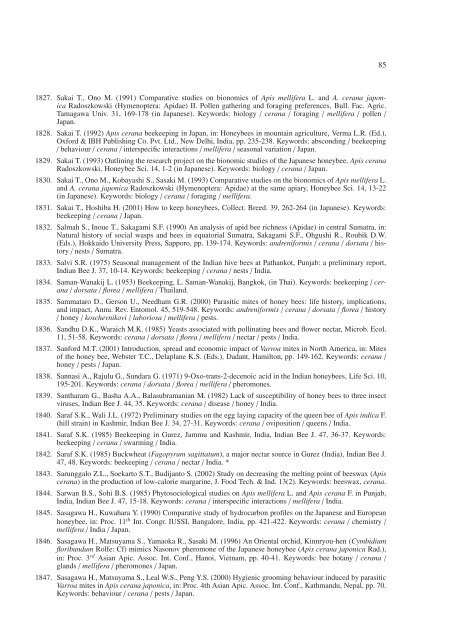Bibliography of Apis cerana Fabricius - Apidologie
Bibliography of Apis cerana Fabricius - Apidologie
Bibliography of Apis cerana Fabricius - Apidologie
You also want an ePaper? Increase the reach of your titles
YUMPU automatically turns print PDFs into web optimized ePapers that Google loves.
1827. Sakai T., Ono M. (1991) Comparative studies on bionomics <strong>of</strong> <strong>Apis</strong> mellifera L. and A. <strong>cerana</strong> japonica<br />
Radoszkowski (Hymenoptera: Apidae) II. Pollen gathering and foraging preferences, Bull. Fac. Agric.<br />
Tamagawa Univ. 31, 169-178 (in Japanese). Keywords: biology / <strong>cerana</strong> / foraging / mellifera / pollen /<br />
Japan.<br />
1828. Sakai T. (1992) <strong>Apis</strong> <strong>cerana</strong> beekeeping in Japan, in: Honeybees in mountain agriculture, Verma L.R. (Ed.),<br />
Oxford & IBH Publishing Co. Pvt. Ltd., New Delhi, India, pp. 235-238. Keywords: absconding / beekeeping<br />
/ behaviour / <strong>cerana</strong> / interspecific interactions / mellifera / seasonal variation / Japan.<br />
1829. Sakai T. (1993) Outlining the research project on the bionomic studies <strong>of</strong> the Japanese honeybee, <strong>Apis</strong> <strong>cerana</strong><br />
Radoszkowski, Honeybee Sci. 14, 1-2 (in Japanese). Keywords: biology / <strong>cerana</strong> / Japan.<br />
1830. Sakai T., Ono M., Kobayashi S., Sasaki M. (1993) Comparative studies on the bionomics <strong>of</strong> <strong>Apis</strong> mellifera L.<br />
and A. <strong>cerana</strong> japonica Radoszkowski (Hymenoptera: Apidae) at the same apiary, Honeybee Sci. 14, 13-22<br />
(in Japanese). Keywords: biology / <strong>cerana</strong> / foraging / mellifera.<br />
1831. Sakai T., Hoshiba H. (2001) How to keep honeybees, Collect. Breed. 39, 262-264 (in Japanese). Keywords:<br />
beekeeping / <strong>cerana</strong> / Japan.<br />
1832. Salmah S., Inoue T., Sakagami S.F. (1990) An analysis <strong>of</strong> apid bee richness (Apidae) in central Sumatra, in:<br />
Natural history <strong>of</strong> social wasps and bees in equatorial Sumatra, Sakagami S.F., Ohgushi R., Roubik D.W.<br />
(Eds.), Hokkaido University Press, Sapporo, pp. 139-174. Keywords: andreniformis / <strong>cerana</strong> / dorsata / history<br />
/ nests / Sumatra.<br />
1833. Salvi S.R. (1975) Seasonal management <strong>of</strong> the Indian hive bees at Pathankot, Punjab: a preliminary report,<br />
Indian Bee J. 37, 10-14. Keywords: beekeeping / <strong>cerana</strong> / nests / India.<br />
1834. Saman-Wanakij L. (1953) Beekeeping, L. Saman-Wanakij, Bangkok, (in Thai). Keywords: beekeeping / <strong>cerana</strong><br />
/ dorsata / florea / mellifera / Thailand.<br />
1835. Sammataro D., Gerson U., Needham G.R. (2000) Parasitic mites <strong>of</strong> honey bees: life history, implications,<br />
and impact, Annu. Rev. Entomol. 45, 519-548. Keywords: andreniformis / <strong>cerana</strong> / dorsata / florea / history<br />
/ honey / koschevnikovi / laboriosa / mellifera / pests.<br />
1836. Sandhu D.K., Waraich M.K. (1985) Yeasts associated with pollinating bees and flower nectar, Microb. Ecol.<br />
11, 51-58. Keywords: <strong>cerana</strong> / dorsata / florea / mellifera / nectar / pests / India.<br />
1837. Sanford M.T. (2001) Introduction, spread and economic impact <strong>of</strong> Varroa mites in North America, in: Mites<br />
<strong>of</strong> the honey bee, Webster T.C., Delaplane K.S. (Eds.), Dadant, Hamilton, pp. 149-162. Keywords: <strong>cerana</strong> /<br />
honey / pests / Japan.<br />
1838. Sannasi A., Rajulu G., Sundara G. (1971) 9-Oxo-trans-2-decenoic acid in the Indian honeybees, Life Sci. 10,<br />
195-201. Keywords: <strong>cerana</strong> / dorsata / florea / mellifera / pheromones.<br />
1839. Santharam G., Basha A.A., Balasubramanian M. (1982) Lack <strong>of</strong> susceptibility <strong>of</strong> honey bees to three insect<br />
viruses, Indian Bee J. 44, 35. Keywords: <strong>cerana</strong> / disease / honey / India.<br />
1840. Saraf S.K., Wali J.L. (1972) Preliminary studies on the egg laying capacity <strong>of</strong> the queen bee <strong>of</strong> <strong>Apis</strong> indica F.<br />
(hill strain) in Kashmir, Indian Bee J. 34, 27-31. Keywords: <strong>cerana</strong> / oviposition / queens / India.<br />
1841. Saraf S.K. (1985) Beekeeping in Gurez, Jammu and Kashmir, India, Indian Bee J. 47, 36-37. Keywords:<br />
beekeeping / <strong>cerana</strong> / swarming / India.<br />
1842. Saraf S.K. (1985) Buckwheat (Fagopyrum sagittatum), a major nectar source in Gurez (India), Indian Bee J.<br />
47, 48. Keywords: beekeeping / <strong>cerana</strong> / nectar / India. *<br />
1843. Sarunggalo Z.L., Soekarto S.T., Budijanto S. (2002) Study on decreasing the melting point <strong>of</strong> beeswax (<strong>Apis</strong><br />
<strong>cerana</strong>) in the production <strong>of</strong> low-calorie margarine, J. Food Tech. & Ind. 13(2). Keywords: beeswax, <strong>cerana</strong>.<br />
1844. Sarwan B.S., Sohi B.S. (1985) Phytosociological studies on <strong>Apis</strong> mellifera L. and <strong>Apis</strong> <strong>cerana</strong> F. in Punjab,<br />
India, Indian Bee J. 47, 15-18. Keywords: <strong>cerana</strong> / interspecific interactions / mellifera / India.<br />
1845. Sasagawa H., Kuwahara Y. (1990) Comparative study <strong>of</strong> hydrocarbon pr<strong>of</strong>iles on the Japanese and European<br />
honeybee, in: Proc. 11th Int. Congr. IUSSI, Bangalore, India, pp. 421-422. Keywords: <strong>cerana</strong> / chemistry /<br />
mellifera / India / Japan.<br />
1846. Sasagawa H., Matsuyama S., Yamaoka R., Sasaki M. (1996) An Oriental orchid, Kinnryou-hen (Cymbidium<br />
floribundum Rolfe: Cf) mimics Nasonov pheromone <strong>of</strong> the Japanese honeybee (<strong>Apis</strong> <strong>cerana</strong> japonica Rad.),<br />
in: Proc. 3rd Asian Apic. Assoc. Int. Conf., Hanoi, Vietnam, pp. 40-41. Keywords: bee botany / <strong>cerana</strong> /<br />
glands / mellifera / pheromones / Japan.<br />
1847. Sasagawa H., Matsuyama S., Leal W.S., Peng Y.S. (2000) Hygienic grooming behaviour induced by parasitic<br />
Varroa mites in <strong>Apis</strong> <strong>cerana</strong> japonica, in: Proc. 4th Asian Apic. Assoc. Int. Conf., Kathmandu, Nepal, pp. 70.<br />
Keywords: behaviour / <strong>cerana</strong> / pests / Japan.<br />
85




